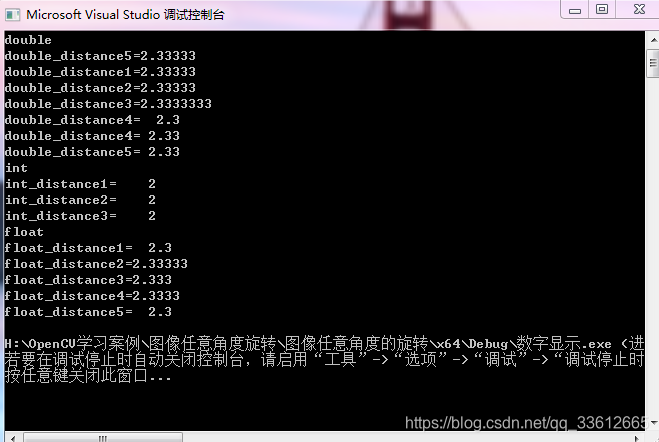【1】任意位数显示
#include "pch.h"
#include <iostream>
#include <iomanip>
using namespace std;
int main()
{
double a = 7;
double b = 3;
double c = a / b;
double d = 7 / 3;
//float和double默认情况下显示六位有效数字
//float和double默认情况下显示六位有效数字
//float和double默认情况下显示六位有效数字
/****************************************************************************************************************/
//因为double类型有六个位数setprecision(0)到setprecision(6)显示的效果一样
cout << "double" << endl;
cout << "double_distance5=" << setw(5) << c << endl;//2.33333 默认显示六位小数
cout << "double_distance1=" << setw(5) << setprecision(0) << c << endl; //2.33333 显示效果setprecision(0) << c =c
cout << "double_distance2=" << setw(5) << setprecision(6) << c << endl; //2.33333 默认显示六位小数
cout << "double_distance3=" << setw(5) << setprecision(8) << c << endl; //2.3333333 保留八位小数
cout << "double_distance4=" << setw(5) << setprecision(2) << c << endl; //2.3 保留一位小数
cout << "double_distance4=" << setw(5) << setprecision(3) << c << endl; //2.33 保留两位小数
cout << "double_distance5=" << setw(5) << c << endl;//2.33 原因是此行代码直接读取上一行代码的值
/****************************************************************************************************************/
/****************************************************************************************************************/
//int是整形所以显示效果一样
cout << "int" << endl;
int e = a / b;
cout << "int_distance1=" << setw(5) << setprecision(1) << e << endl; //2
cout << "int_distance2=" << setw(5) << e << endl;//2
cout << "int_distance3=" << setw(5) << setprecision(2) << e << endl; //2
/****************************************************************************************************************/
/****************************************************************************************************************/
float f = a / b;
cout << "float" << endl;
cout << "float_distance1=" << setw(5) << f << endl; //2.3
cout << "float_distance2=" << setw(5) << setprecision(0) << f << endl; //2.33333
cout << "float_distance3=" << setw(5) << setprecision(4) << f << endl; //2.333
cout << "float_distance4=" << setw(5) << setprecision(5) << f << endl; //2.3333
cout << "float_distance5=" << setw(5) << setprecision(2) << f << endl; //2.3
/****************************************************************************************************************/
/**************************************解释说明*****************************************************/
//单精度浮点数在机内占4个字节,用32位二进制描述。一个字节为八个位
//双精度浮点数在机内占8个字节,用64位二进制描述。
//浮点数在机内用指数型式表示,分解为:数符,尾数,指数符,指数四部分。
//数符占1位二进制,表示数的正负。
//指数符占1位二进制,表示指数的正负。
//尾数表示浮点数有效数字,0.xxxxxxx, 但不存开头的0和点
//指数存指数的有效数字。
//指数占多少位,尾数占多少位,由计算机系统决定。
//可能是数符加尾数占24位,指数符加指数占8位-- float.
//数符加尾数占48位,指数符加指数占16位-- double.
//知道了这四部分的占位,按二进制估计大小范围,再换算为十进制,就是你想知道的数值范围。
//对编程人员来说,double 和 float 的区别是double精度高,有效数字16位,float精度7位。
//但double消耗内存是float的两倍,double的运算速度比float慢得多,C语言中数学函数名称double 和 float不同,
//不要写错,能用单精度时不要用双精度(以省内存,加快运算速度)。
}

【2】数字任意小数显示并保存
// ConsoleApplication1.cpp : 此文件包含 "main" 函数。程序执行将在此处开始并结束。
//
#include "pch.h"
#include <iostream>
#include <sstream>
#include <iomanip>
using namespace std;
//精度转换函数
float round(float src, int bits){
stringstream ss;
ss << fixed << setprecision(bits) << src;
ss >> src;
return src;
}
int main()
{
float src = 1.123456789;
float f = round(src, 2);
cout << f << endl; //1.12
cin.get();
}
【3】参考文献
setprecision、fixed、showpoint的用法总结(经典!!超经典!!)
C / C++ 保留两位小数(setprecision(n)的一些用法总结)








 本文介绍了C++中如何使用setprecision控制浮点数的显示精度,并提供了具体示例,包括任意位数显示、数字任意小数显示及保存的方法。
本文介绍了C++中如何使用setprecision控制浮点数的显示精度,并提供了具体示例,包括任意位数显示、数字任意小数显示及保存的方法。
















 1万+
1万+

 被折叠的 条评论
为什么被折叠?
被折叠的 条评论
为什么被折叠?








